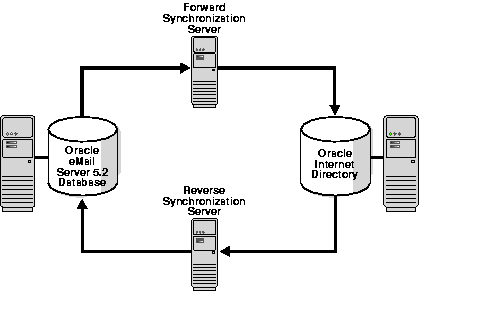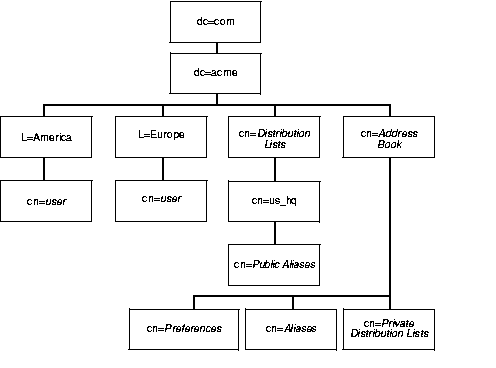Release 1 (v1.0.2.2)
Part Number A90433-01
Library |
Solution Area |
| Oracle9iAS Email Release 1 (v1.0.2.2) Part Number A90433-01 |
|
Oracle is a registered trademark, and Oracle9i is a trademark or registered trademark of Oracle Corporation. Other names may be trademarks of their respective owners.
Copyright © 2001, Oracle Corporation.
All Rights Reserved.
Integration with Oracle Internet Directory
May 2001
Part No. A90433-01
This presentation explains how Oracle9iAS Email 5.2 uses Oracle Internet Directory. Directory support for Oracle9iAS Email is still evolving and will be better defined in version 6.0, when the product will be fully integrated with the directory.
The presentation covers the following topics:
Oracle9iAS Email uses mail servers based on standards defined by the Internet Engineering Task Force (IETF) to access, manipulate, route, and deliver electronic mail messages stored in Oracle databases. Two of these servers, IMAP and POP3, perform the first two functions. A third, SMTP, performs the latter two functions. These servers are built on a multithreaded architecture provided by the Oracle InterOffice Scalable Protocol Server. This feature enables support for thousands of users who are logged on simultaneously.
Both IMAP4 and POP3 are Internet mail standards widely used and accepted in the Internet community. Some of the better-known IMAP4 and POP3 clients are Netscape Communicator, Outlook Express, Eudora, and Pine.
Oracle9iAS Email currently uses only the public namespace of Oracle Internet Directory. Here it stores data pertaining to public address books. This data consists of user names, distribution lists, and aliases for distribution lists. Clients of Oracle Web Mail, a thin client mail application, have their own, private address book container in the directory. This container holds subcontainers for aliases, preferences, and private distribution lists.
Oracle9iAS Email currently manages all of its directory data in a proprietary database directory schema. To enable IETF standards-based messaging clients such as Netscape to access this information, a forward synchronization engine updates Oracle Internet Directory whenever a user, distribution list, or alias is created in the messaging database. Similarly, when an entry is created in Oracle Internet Directory, a reverse synchronization engine creates the same entry in the messaging database. This forward/reverse synchronization enables e-mail accounts to be created and user data to be administered either in the messaging database or in Oracle Internet Directory. In any event, the delivery of messages and the authentication of users is performed using tables located in the Oracle9iAS Email database.
Figure 1 illustrates the synchronization process.

In version 6.0 of Oracle9iAS Email, product metadata as well as public address books will be managed in Oracle Internet Directory. This means that Oracle9iAS Email will receive its own product container under the Oracle Context, the directory repository for all Oracle product-related information.
As Figure 2 illustrates, an enterprise--in this case, the hypothetical company acme--that uses Oracle9iAS Email 5.2 requires directory entries for the following data categories:

Oracle9iAS Email places no restriction on public data, but the entry for the private address book has an access control list (ACL) that grants the Web server administrator, and no one else, access to the container.
This section lists and describes the object classes and attributes that Oracle9iAS Email uses to define directory entries. Note that the object classes are all auxiliary classes.
The section contains the following topics:
The following object classes and attributes define user entries, public distribution lists, and aliases for these lists.
orclperson
Defines a user
orclalias
Identifies a public alias
orcldomain
Identifies the domain within which an entry is located
orcllocation
Identifies the geographical domain within which a user entry is located
orclorganization
Identifies the organizational unit within which a user entry is located
orclrole
Identifies a user's job title
orclroom
Identifies the location of a conference room
The following object classes and attributes define user preferences, aliases, and private distribution lists.
orclMailActionColor
Identifies colors for action buttons
orclMailBGColor
Identifies the background color for the mail display
orclMailCopytoSent
Identifies whether copies of e-mail are placed in a Sent folder
orclMailDisplayDeleted
Determines whether deleted mail can be displayed
orclMailDisplayXHeaders
Determines whether extended headers can be displayed
orclMailExternalAccess
Determines whether mail can be accessed from an external network
orclMailFGColor
Identifies the foreground color for a mail display
orclMailForwardFormat
Determines whether mail can be forwarded
orclMailName
Identifies an alternative name for a mail user
orclMailNumDisplay
Identifies how many lines of mail are displayed
orclMailOffColor
Identifies the color of unselected mail
orclMailOnColor
Identifies the color of selected mail
orclMailPOPAccount
Identifies the post office account from which messages are downloaded
orclMailReplyFormat
Identifies the format for mail replies--indents or carets, for instance
orclMailSignature
Identifies a user's mail signature
orclMailTimeZone
Identifies a mail user's time zone
|
|
 Copyright © 2001 Oracle Corporation. All Rights Reserved. |
|